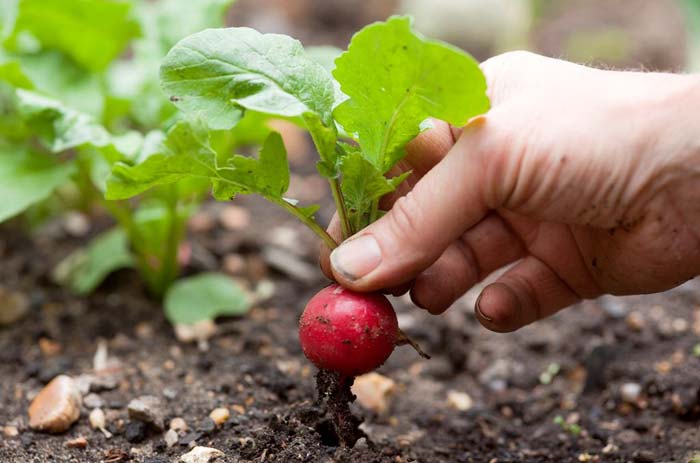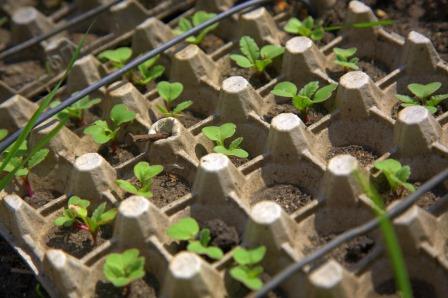Seasonal cultivation of radishes in a greenhouse in winter is a task that newbies can afford. The first rule is the choice of a cold-resistant variety. The top list includes “Gribovsky”, “early red”, “ruby”, “dawn” and so on. From the moment of planting to harvest, 25-30 days will pass. The second rule - in a closed environment, the vegetable needs artificial lighting. In the case when the design of the greenhouse does not allow the installation of additional light sources, early-growing winter-hardy varieties are worth growing. These are Tarzan, Debel, Coral and Donar.
Content
Preparing the soil for planting
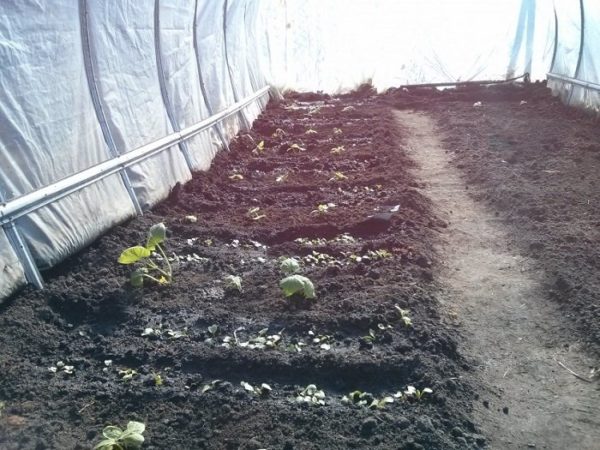 Botanists distinguish 4 technologies for preparing nutritious soil. The gardener chooses any of them.
Botanists distinguish 4 technologies for preparing nutritious soil. The gardener chooses any of them.
|
Option 1 |
Option 2 |
Option 3 |
Option 4 |
|
4 kg of dung peat and 4 kg of turf land. |
4 kg of field soil and 6 kg of dung humus. |
4 kg of turf land and 5 kg of dung humus. |
5 kg of turf land and 5 kg of greenhouse soil. |
|
Add 2 kg of lowland peat. |
Stir until smooth. |
||
|
On 1 m2 of the greenhouse use 2 kg of the finished mixture. |
|||
Planted seeds in mid-January
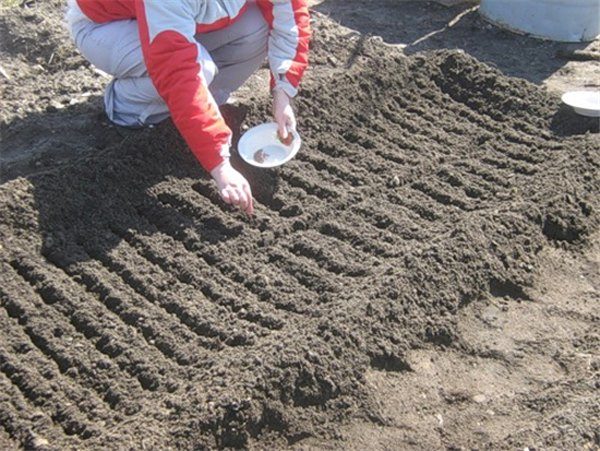 They start work in the greenhouse on the day when the average temperature inside the greenhouse does not fall below "0".
They start work in the greenhouse on the day when the average temperature inside the greenhouse does not fall below "0".
- after 36 hours, the gardener checks the condition of the soil;
- seeds can be planted if the soil has become soft;
- minimum row spacing: 10 cm;
- recommended landing depth: 2-3 cm.
After planting, the future radish is covered. Over the next 3-5 days, the seeds are acclimatized.
Radish needs minimal maintenance
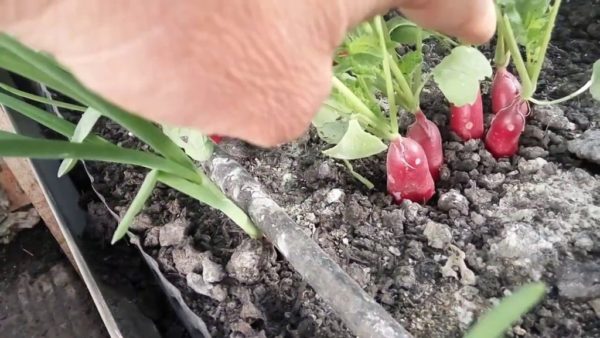 As soon as the radish planted on the site has ascended in winter, it is thinned out. There should be at least 2 cm between plantings. Otherwise, the shoots will create an excessive shadow. The less light an adjacent landing receives, the slower its growth rate. Pay attention to a sufficient degree of illumination of the greenhouse. Proper cultivation on a radish site in winter implies a 9-hour daylight. We are talking about the high intensity and brightness of the light flux. If it is dark in the greenhouse, then the gardener installs additional light sources. They are positioned so that there are no "dark spots" inside.
As soon as the radish planted on the site has ascended in winter, it is thinned out. There should be at least 2 cm between plantings. Otherwise, the shoots will create an excessive shadow. The less light an adjacent landing receives, the slower its growth rate. Pay attention to a sufficient degree of illumination of the greenhouse. Proper cultivation on a radish site in winter implies a 9-hour daylight. We are talking about the high intensity and brightness of the light flux. If it is dark in the greenhouse, then the gardener installs additional light sources. They are positioned so that there are no "dark spots" inside.
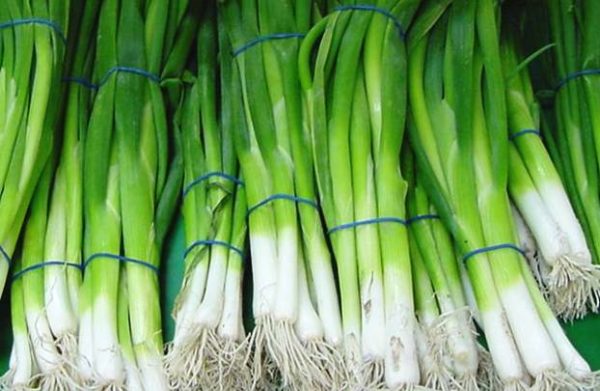 You may be interested in:
You may be interested in:Regular top dressing and watering
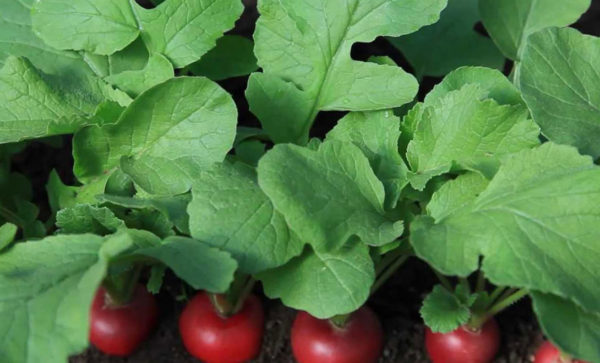 Every 6-8 days they feed a planted winter variety of radish. Use "organic", for example, humus. 500 g of nitrogen fertilizers and 100 g of peat are added to the nutrient mixture. The ingredients are mixed until smooth. For every 1 m2, up to 500 g of the finished composition is consumed. The second caveat - radish needs normalized watering.Depending on the region, the soil in a greenhouse loses moisture in 3-5 days. On 1 m2 leaves up to 1 liter of water.
Every 6-8 days they feed a planted winter variety of radish. Use "organic", for example, humus. 500 g of nitrogen fertilizers and 100 g of peat are added to the nutrient mixture. The ingredients are mixed until smooth. For every 1 m2, up to 500 g of the finished composition is consumed. The second caveat - radish needs normalized watering.Depending on the region, the soil in a greenhouse loses moisture in 3-5 days. On 1 m2 leaves up to 1 liter of water.
Recommended irrigation scheme - 1 time every 3 days. Before the next introduction of water into the soil, the gardener checks the degree of moisture. Excessive watering will provoke rotting of the root system.
Comfortable temperature
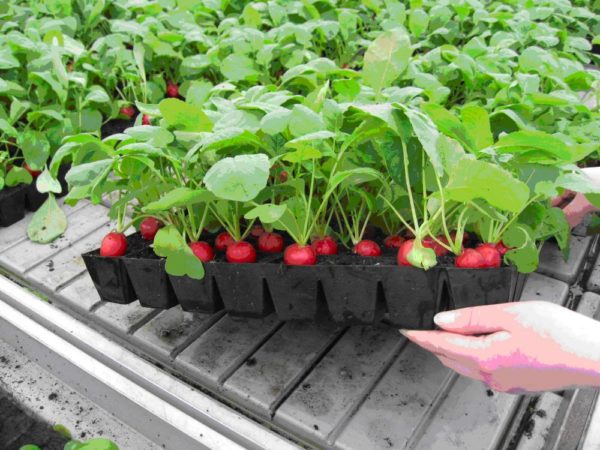 The gardener should know that for growing radishes in a greenhouse in the winter for sale or for their own needs, a vegetable should provide a comfortable temperature range:
The gardener should know that for growing radishes in a greenhouse in the winter for sale or for their own needs, a vegetable should provide a comfortable temperature range:
- germination stage (minimum): +2 + 3 C;
- germination stage (desirable): +8 +10 C;
- seedlings "hatch" (minimum): +8 + 10 C;
- seedlings "hatch" (preferably): +12 + 14 C;
- active growth (minimum): +20 + 21 C.
Figures vary by grade. Comprehensive information is presented on the packaging with seeds.
 You may be interested in:
You may be interested in:Harvesting and storage
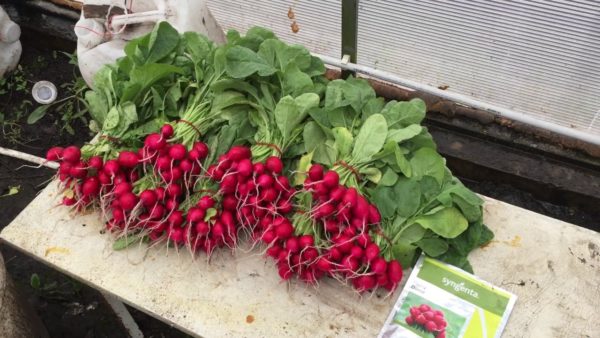 You can enjoy the radish after the fruits reach its characteristic size and color. Botanists recommend not postpone collection. Otherwise, the vegetable will lose its nutritional properties. On the day when it is planned to harvest, spend the last watering in the region of 8-9 hours in the morning. Harvest about 14-15 hours. The procedure is as follows:
You can enjoy the radish after the fruits reach its characteristic size and color. Botanists recommend not postpone collection. Otherwise, the vegetable will lose its nutritional properties. On the day when it is planned to harvest, spend the last watering in the region of 8-9 hours in the morning. Harvest about 14-15 hours. The procedure is as follows:
- carefully extract the vegetable from the ground;
- cut the tops (it is then used to mulch the soil);
- carefully remove the leaves - take care not to harm the fetus;
- washed fruits in a large volume of cold water;
- wipe the radish with a paper towel;
- stack the fruits in a plastic bag.
Harvested vegetables are stored in the refrigerator for 4 weeks.
Growing radishes for sale
The state provides support to agricultural producers. Gardeners who want to sell radishes are betting on traditional varieties. "Exotic" species introduce gradually. First you need to check how they are perceived by a potential buyer. The following recommendations will help minimize the likelihood of problems:
- as the demand for the product increases, new plots of land are bought to expand the sown area;
- seeds are planted 1 time every 14 days - in cold winters and in warmer times the gardener will ensure the constant availability of fresh goods;
- planting is carried out using well-established varieties;
- peak demand - summer and winter.
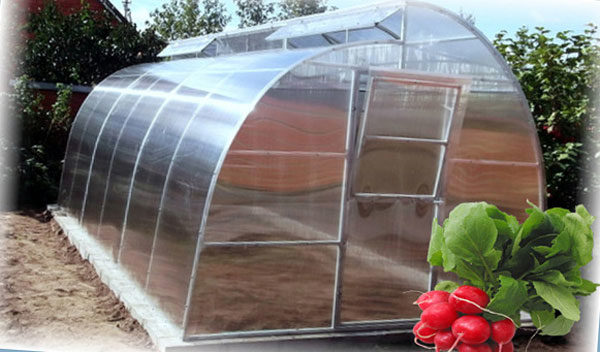 Radish - An unpretentious vegetable that is planted in a greenhouse in mid-January. Landing is carried out using cold-resistant varieties. Regardless of the region of residence, it is possible to send seeds to closed ground when the average night temperature does not fall below 0 + 2C, and the daytime temperature is +15 +17 C. The root crop needs minimal care. The gardener must provide him with a 10-hour light day, regulated watering and top dressing.
Radish - An unpretentious vegetable that is planted in a greenhouse in mid-January. Landing is carried out using cold-resistant varieties. Regardless of the region of residence, it is possible to send seeds to closed ground when the average night temperature does not fall below 0 + 2C, and the daytime temperature is +15 +17 C. The root crop needs minimal care. The gardener must provide him with a 10-hour light day, regulated watering and top dressing.

